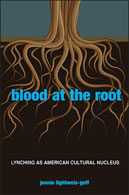Blood at the Root: Lynching as American Cultural Nucleus

Author: Jennie Lightweis-Goff
Publisher: Albany, NY: State University of New York Press, 2011. 217p.
Reviewer: Cory Schnell | March 2012
Blood at the Root is an impressive effort to better understand the prevalence and embeddedness of lynching in American culture. Popular culture in particular is Lightweis-Goff’s target. What sets Blood at the Roots apart from the many other entries that deal with the overlapping topics of race, lynching, and culture is its unique collection of sources. Lightweis-Goff oscillates between using academia and pop culture artifacts to frame her arguments. The strategy is by no means a gimmick. It is successful on two levels: it helps to prove the point about the saturation of American culture with racial and lynching sentiments. It also is successful because it keeps the reader entertained, which is a triumph on its own for an “academic” book. Both of those achievements make Blood at the Root a compelling study on lynching and American culture.
The main analysis of the book breaks down into four sections with distinct themes. The first advances the idea that racism and lynching are not simply just a problem isolated in the south but a part of a general American ideology. Lightweis-Goff frames this chapter around the experiences and work of author Richard Wright. The second major thematic portion hinges on a science fiction novel by George Schuyler titled Black No More. The central premise of this novel is about a device which can change the color of one’s skin. Lightweis-Goff conducts thought provoking extrapolations from this fiction narrative which focus on how racism is more than skin deep.
William Faulkner’s work and personal experiences are dissected to better help understand the pathology of lynching in the third section. Lynching is a subject Faulkner has covered repeatedly in his impressive canon. Although Faulkner claimed to never have “seen” a lynching Lightweis-Goff points out that a lynching did occur outside of Faulkner’s house as a child. These two occurrences are not a coincidence in her eyes. Finally, the last major thematic area of the book features a discussion about lynching photography, the exhibition of these photographs, and the agency of women. Lightweis-Goff discusses the morally ambiguous stance of these photographs and their exhibitions as well as the scope of women’s involvement with lynchings.
All four of the major thematic expositions in the book are sandwiched between a comprehensive introduction to lynching and a conclusion/coda which features the author visiting three lynching sites. Lightweis-Goff chronicles how the former lynching sites, and communities whose ancestors did the lynching, retroactively handled the events differently.
Blood at the Root is at its core about the intersection of race and crime in American culture. Lightweis-Goff subtitles the book Lynching as American Cultural Nucleus to make this point clear from the start. One of the few shortcomings in the book though is that for all its ambition, and the complexity of the chosen topic, the book is painfully too short. Attempting to give a comprehensive and exhaustive analysis of lynching and culture in under two hundred pages is near impossible.
In the eyes of many American’s lynching is a ghost of our cultural past that we would love to keep hidden away. Lightweis-Goff argues that no matter how hard some people would like to forget, the scars left on this country from lynching will never go away. They will remain in our culture, conscience, and country forever.
Cory Schnell is a Graduate Student at Rutgers University School of Criminal Justice.


